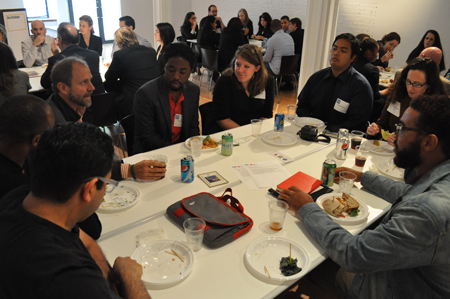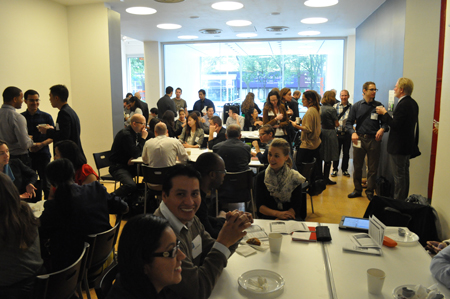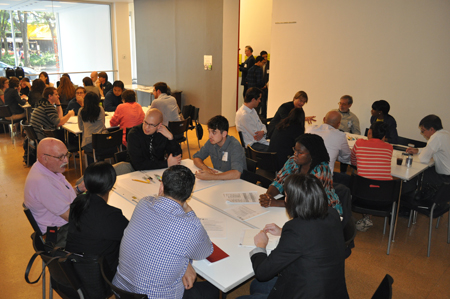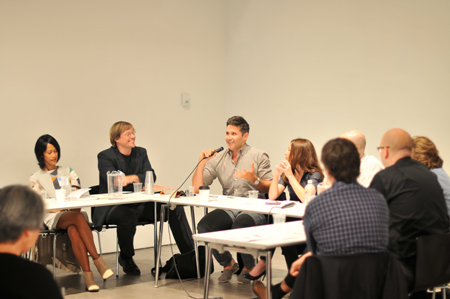by: Julie Engh Assoc. AIA

A lively networking breakfast kicked off the Future Now Summit.
Austin Reed

Keynote speaker futurist David Zach engages the audience in lively debate: how do we reinvent tomorrow when technology is allowing everything – from phones to toilets – to “talk?”
Austin Reed

2012 AIANY Chapter President Joseph J. Aliotta, AIA, LEED AP BD+C, welcomes emerging professionals to what he hopes will be the first of many Future Now Summits.
Austin Reed

During the Fellows networking luncheon, Jonathan Marvel, FAIA, engages young architects in conversation.
Austin Reed

Guided by, among others, Illya Azaroff, AIA, Susan Chin, FAIA, David Fano, Nathan Miller, and Burt Roslyn, FAIA, young architects envision the “future” of architectural practice during the Future Now charrette.
Austin Reed

Marc Kushner, AIA, encourages attendees to learn from the tech industry by identifying and utilizing “disruptive” opportunities. (l-r) Yen Ha; Illya Azaroff, AIA; Marc Kushner, AIA; Molly Heintz; David Fano; Annabelle Selldorf, FAIA; Nathan Miller; Philipp von Dalwig, Assoc. AIA. Not pictured: Chris Leong, Assoc. AIA, Principal, Leong Leong
Ehsanul Haque
Event: The Future Now Summit
Location: The Center for Architecture, 09.22.12
Speakers:
Opening Remarks: Joseph Aliotta, AIA, LEED AP BD+ C, 2012 AIA New York Chapter President; Susan Chin, FAIA, Executive Director, Design Trust for Public Space
Keynote Presentation:
David Zach, futurist, AIA Public Director
Panel Moderators:
Philipp von Dalwig, Assoc. AIA, LEED AP, Principal, Manifold Architecture Studio, Co-Chair, New Practices Committee; Chris Leong, Assoc. AIA, Principal, Leong Leong
Panelists:
Annabelle Selldorf, FAIA, Principal, Selldorf Architects; Marc Kushner, AIA, Principal, HWKN, Architizer.com; Illya Azaroff, AIA, Director, +LAB architects; Molly Heintz, Contributing Editor, The Architect’s Newspaper; David Fano, Partner, CASE Inc.; Nathan Miller, Director, CASE Inc.; Yen Ha, Founder, Front Studio
Participants in the AIA Fellows Mentoring Luncheon:
Sylvia Smith, FAIA; Nathan Hoyt, FAIA; Burton Roslyn, FAIA; Mark Ginsberg, FAIA; Louise Braverman, FAIA; Stanley Stark, FAIA; Jill Lerner, FAIA; Joanna Pestka, FAIA; Carol Kurth, FAIA; Jonathan Marvel, FAIA
Participants in the Future Now Charrette:
Frank Mruk, AIA, RIBA, Associate Dean, NYIT; Dale Cohen, Assoc. AIA, Co-Chair, AIANY Interiors Committee; David Fano, Partner, CASE Inc.; Nathan Miller, Director, CASE Inc.; Susan Chin, FAIA, Executive Director, Design Trust for Public Space; David Zach, Futurist, AIA Public Director; Charles McKinney, Assoc. AIA
Organizers: AIA New York Chapter Emerging New York Architects Committee (ENYA), and presented as part of Future Now, the AIA New York 2012 Presidential Theme.
ENYA Future Now Summit Committee: ENYA Co-chairs Brynnemarie Lanciotti, Assoc. AIA, and Amanda Rivera, Assoc. AIA; Alex Alaimo; Courtney Ferguson, Assoc. AIA; James Yankopoulos, Assoc. AIA; David Flecha, Assoc. AIA; Kunal Ghevaria, LEED AP BD+C; and Ehsanul Haque.
Special thanks to the Sponsors of The Future Now Summit:
Patron: New York Regional Representatives for the College of Fellows
Media Sponsor: Archinect | Bustler
Supporter: Roslyn Consultants, LLC
The Future Now Summit brought together more than 120 emerging and established practitioners at the Center for Architecture to consider the future of the architecture profession. Presented as the signature program event of Future Now, 2012 AIANY President Joseph J. Aliotta’s, AIA, LEED AP, presidential theme, the Summit considered the evolving roles of marketing/branding, social technologies, diverse business models, and civic leadership within the architectural industry. Considering the Summit’s success, Aliotta hopes “this summit will become an annual program at the Center for Architecture to continue this vital dialogue.”
Architects are futurists, keynote speaker futurist David Zach asserted, as we “deal with products and services that live beyond us and our time on this earth.” We must, however, not neglect the present, but instead “always show up being prepared to be no place else.” As boundaries and technological barriers shift and fall, we must consider what architects provide that cannot be automated lest “there’s an app for that” turn into “there’s an app for you.” Our most valuable resource, Zach declared, is our attention; we must therefore be cautious that multitasking not erode our ability to focus and accomplish quality work. Architects can and should be designing beautiful and useful things. Great architecture can inspire awe, as only a magical thing can. We must not apologize for being architects, but instead engage in the conversation and battle over the question: “what is architecture?”
As the panelists and presenters debated about the architectural industry and an architect’s value, it became clear, as Susan Chin, FAIA, succinctly stated, “There is no one way to practice architecture.” Nathan Miller and David Fano of CASE Inc. showcased how architects can harness automation as a tool to work through design criteria and streamline the movement of information. To keep pace with these technological and industry developments, educational and professional organizations need to adapt faster, Yen Ha of Front Studio asserted. Mark Kushner, AIA, of HWKN and Architizer.com, roundly challenged architects to find new ways of communicating to the greater public the value of what they do. Architecture reflects the culture of our time, Illya Azaroff, AIA, believes, and it is the responsibility of architects to create culture where it does not already exist. The process, he acknowledged, can be difficult: at his office the trashcan is routinely considered the most important item.
A mentoring luncheon, sponsored by the New York Regional Representatives of the AIA College of Fellows, paired 10 of these established leaders with emerging professionals. The informal networking session segued into a rousing afternoon charrette where participants designed an ideal “new” architecture practice. Whether it was Pop Up Pods’ proposed 12-by-12-foot flexible, modular, mobile pod, Regen City’s proposal to revitalize aging industrial landscapes by targeting urban blight, Temp Relief’s customizable, region-specific temporary disaster relief structures, or Jump Start’s proposal to provide design services to local communities in a mobile truck, these young professionals proved there are new and exciting frontiers for architectural practice.
Annabelle Selldorf, FAIA, explained that we never have – and never should have – a completely unified architecture profession. By lobbying for and representing all the profession‘s disparate voices, however, the American Institute of Architects seeks to give architects “a seat at the table.” As the AIA repositions itself and the architectural industry within the public realm, we must ask our community how we as thought leaders will contribute not only to the profession, but to the greater good.
To accomplish this, we must, Mark Kushner, AIA, exuberantly declared, “shamelessly self-promote” and “get work!” Find what excites you as a professional and pursue it as much as you can, urged David Fano: “Don’t wait. Do it.”
Read and see more on the Summit’s Tumblr.
Julie Engh, Assoc. AIA, LEED AP, is an intern architect active in the Emerging New York Architects (ENYA) Committee and Architecture Tours Committees.













